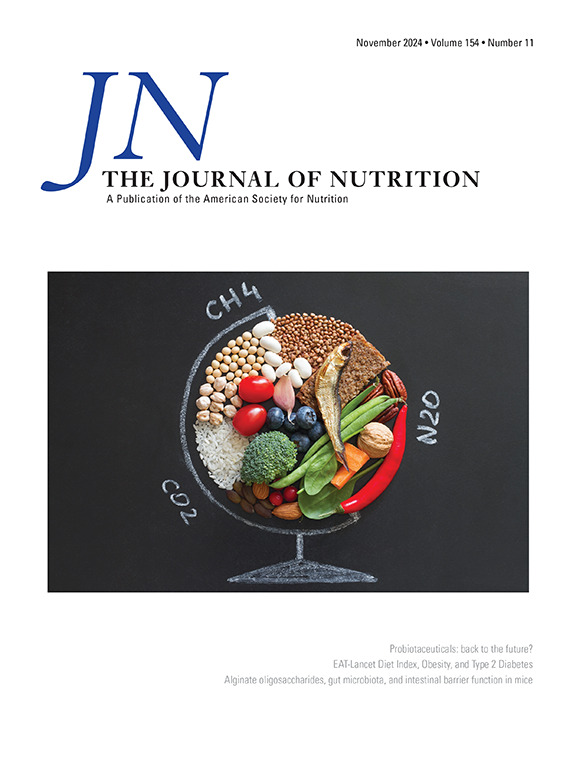在癌症预防研究-3饮食评估子研究中,非营养性甜味剂消费、代谢危险因素和炎症生物标志物
IF 3.7
3区 医学
Q2 NUTRITION & DIETETICS
引用次数: 0
摘要
背景:非营养性甜味剂(NNS)被广泛用于替代添加糖,但其在代谢健康和慢性疾病预防中的作用仍存在争议。目的:研究NNS消费、代谢危险因素和炎症生物标志物之间的关系。方法:这项横断面分析包括美国癌症协会癌症预防研究-3饮食评估子研究(DAS)中的624名成年人。NNS的消耗量包括阿斯巴甜、糖精、三氯蔗糖和乙酰磺胺钾,使用一年内6次24小时饮食召回报告的平均量进行估计。测定空腹胰岛素、c肽、血红蛋白A1c (HbA1c)、瘦素、脂联素、c反应蛋白(CRP)、肿瘤坏死因子α (TNF-α)、白细胞介素-6 (IL-6)、白细胞介素-10 (IL-10)的含量,每隔6个月采集两次。使用多变量线性回归来检查NNS消耗与每种代谢或炎症生物标志物的平均水平之间的关系。根据年龄、性别、种族、教育程度、吸烟和体育活动调整基本模型;根据BMI、饮食质量(HEI-2020)和能量摄入进一步调整完整模型。结果:超过一半(55%)的参与者报告服用NNS(平均每日NNS摄入量7,38和221毫克)。在调整BMI、饮食质量和能量摄入之前,NNS消耗与瘦素(p-trend = 0.0006)和CRP (p-trend = 0.02)呈正相关。NNS消耗与胰岛素、c肽、HbA1c、脂联素、TNF-α或IL-10之间无关联。在按BMI分层的分析中,在BMI≥25kg/m2的参与者中,NNS摄入量与IL-6呈正相关,但与BMI 2无关。结论:在调整了能量摄入和BMI后,整个样本的结果基本为零;但在超重或肥胖的参与者中,NNS的摄入量与IL-6呈正相关。研究NNS消费可能影响炎症途径的机制是必要的。本文章由计算机程序翻译,如有差异,请以英文原文为准。
Nonnutritive Sweetener Consumption, Metabolic Risk Factors, and Inflammatory Biomarkers Among Adults in the Cancer Prevention Study-3 Diet Assessment Sub-Study
Background
Nonnutritive sweeteners (NNSs) are widely used to replace added sugars, yet their role in metabolic health and chronic disease prevention is debated.
Objective
The objective of this study was to examine associations between NNS consumption, metabolic risk factors, and inflammatory biomarkers.
Methods
This cross-sectional analysis included 624 adults in the American Cancer Society’s Cancer Prevention Study-3 Diet Assessment Substudy (DAS). Consumption of NNS, including aspartame, saccharin, sucralose, and acesulfame-potassium, was estimated using the mean quantities reported in 6 24-h dietary recalls over 1 y. Fasting insulin, C-peptide, hemoglobin A1c (HbA1c), leptin, adiponectin, C-reactive protein (CRP), tumor necrosis factor-alpha (TNF-α), interleukin-6 (IL-6), and interleukin-10 (IL-10) were measured in fasting blood samples collected twice, 6 mo apart. Multivariable linear regression was used to examine associations between NNS consumption and the mean levels of each metabolic or inflammatory biomarker. Base models were adjusted for age, sex, race, education, smoking, and physical activity; full models were further adjusted for body mass index (BMI), diet quality (Healthy Eating Index 2020), and energy intake.
Results
More than half (55%) of participants reported consuming NNS (mean daily NNS consumption 7, 38, and 221 mg across tertiles). NNS consumption was positively associated with leptin (P-trend = 0.0006) and CRP (P-trend = 0.02), but associations were attenuated after adjustment for BMI, diet quality, and energy intake. NNS consumption was not associated with insulin, C-peptide, HbA1c, adiponectin, TNF-α, or IL-10. In analyses stratified by BMI, NNS consumption was positively associated with IL-6 among participants with BMI ≥25kg/m2 but not BMI <25kg/m2.
Conclusions
Findings in the full sample were null after adjustment for energy intake and BMI, but NNS consumption was positively associated with IL-6 among participants with overweight or obesity. Investigation of mechanisms through which NNS consumption may impact inflammatory pathways is warranted.
求助全文
通过发布文献求助,成功后即可免费获取论文全文。
去求助
来源期刊

Journal of Nutrition
医学-营养学
CiteScore
7.60
自引率
4.80%
发文量
260
审稿时长
39 days
期刊介绍:
The Journal of Nutrition (JN/J Nutr) publishes peer-reviewed original research papers covering all aspects of experimental nutrition in humans and other animal species; special articles such as reviews and biographies of prominent nutrition scientists; and issues, opinions, and commentaries on controversial issues in nutrition. Supplements are frequently published to provide extended discussion of topics of special interest.
 求助内容:
求助内容: 应助结果提醒方式:
应助结果提醒方式:


